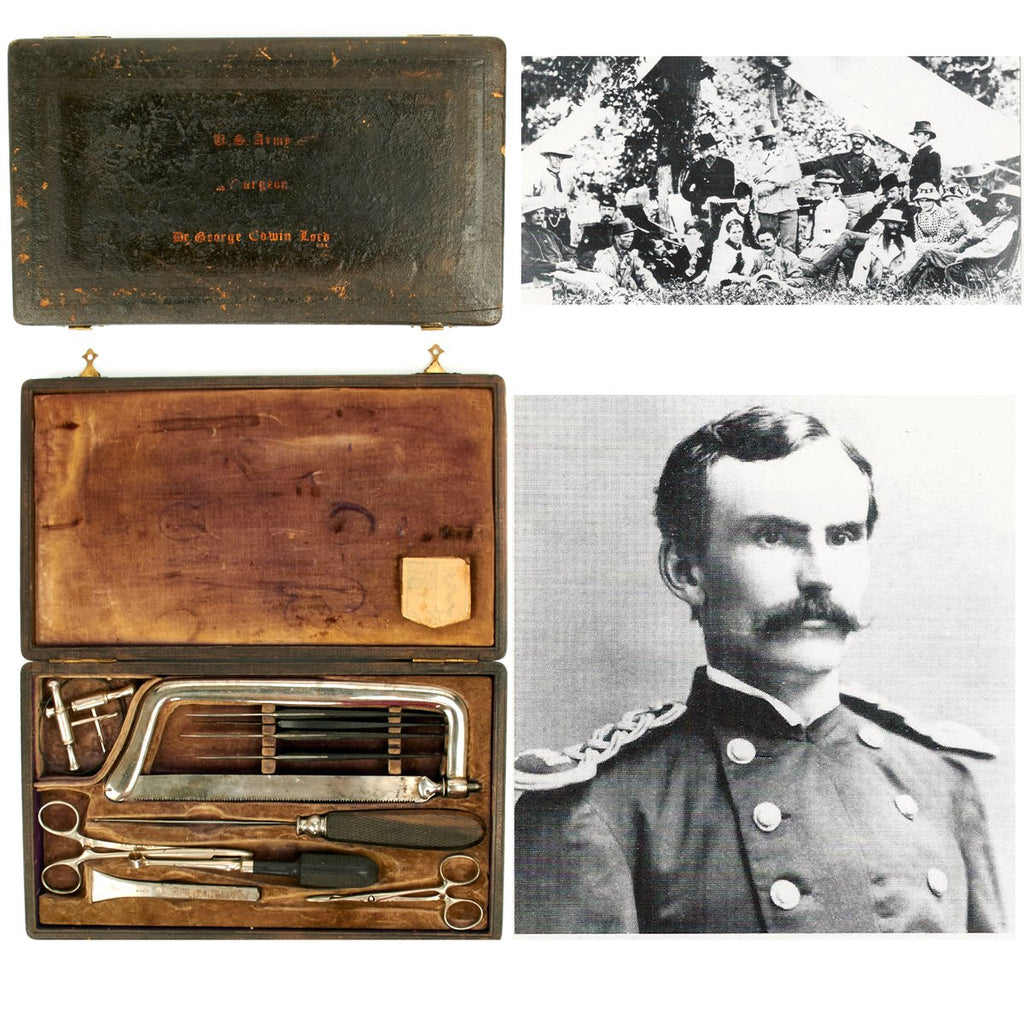-
Original Item: One-of-a-kind. George Edwin Lord (February 17, 1846 - June 25, 1876) was a U.S. Army Assistant Surgeon in the 7th Cavalry who was killed in the Battle of the Little Big Horn in Montana Territory during the Black Hills War.
Lord was born in Brunswick, Maine and graduated from Bowdoin College. He attended medical school and moved west to serve in the U.S. Army at various forts and outposts. He entered into another contract with the U. S. Army in January 1875 and was made a first lieutenant in the 7th Cavalry, posted in Fort Abraham Lincoln in the Dakota Territory.
During the Great Sioux War, he accompanied Lt. Col. George Armstrong Custer's column towards the Little Bighorn River, where he was killed in action. Dr. Lord's body was not positively identified by the first burial crews, and he was initially listed by General Alfred H. Terry and others as missing in action. Captain Otto E. Michaelis and Lieutenant Richard E. Thompson, however, later contacted Lord's brother with their belief that a body sighted on the field had been the doctor's, based on a blue shirt the corpse was wearing as well as "the shapely hands, the mustache, and general appearance. Michaelis also thought the socks on the corpse were from the same set of three pairs Lord had earlier purchased from a trader at Powder River. Based on this new information, three months after the battle Terry recommended that Lord's status be changed to killed in action.
However, there is no marker with Lord's name at the Little Bighorn Battlefield National Monument that specifically marks this reported death site. In 1890, a marker for Lord was placed on the so-called South Skirmish Line, based on the discovery there of buttons that were thought to be part of a staff officer's uniform which doctors would wear.
Lord's surgical kit eventually was recovered from the Indians and sent to the Army's medical museum. After the first world war the kit was decommissioned by the museum and remained in private collection until 2017.
The surgical kit here is is leather covered wood case that measures 12’ x 7’ x 1.5. It is embossed in gold on the exterior lid:
U.S. Army
as. Surgeon
Dr. George Edwin Lord
U.S.A.The interior is velvet lined which appears to have once been a deep purple color but has faded. There are multiple inlay sections for various medical instruments, many of which appear to be original to the case and are marked, Windler. H Windler was a German surgical instrument maker working in the mid 1800s. Medical instruments were commonly imported by American firms to market in the USA. Intact the interior of the case bears a label the reads in part ASTORIA, L.I. and U.S. We suspect some of the instrument are not original to the case but the bone saw and many others appear to be correct.
It is not possible for us to verify if this surgical set was the very same one recovered after the Battle of Little Big Horn found in an Indian camp. However, there is no doubt that this kit belonged to Dr. George Edwin Lord who was Killed in Action during the battle.
There have been numerous articles written about Lord, some of which will be included in with purchase. While there was much speculation about his death and subsequent identification or lack thereof, records do indicate that he was a personal friend of Custer and despite feeling ill that fateful accompanied his friend and commanding officer into a battle that would be their last.
Battle of the Little Bighorn:
The Battle of the Little Bighorn, known to the Lakota and other Plains Indians as the Battle of the Greasy Grass and commonly referred to as Custer's Last Stand, was an armed engagement between combined forces of the Lakota, Northern Cheyenne, and Arapaho tribes and the 7th Cavalry Regiment of the United States Army. The battle, which occurred June 2526, 1876, near the Little Bighorn River in eastern Montana Territory, was the most prominent action of the Great Sioux War of 1876.
The fight was an overwhelming victory for the Lakota, Northern Cheyenne, and Arapaho, led by several major war leaders, including Crazy Horse and Chief Gall, inspired by the visions of Sitting Bull (T?at?á?ka Íyotake). The U.S. 7th Cavalry, including the Custer Battalion, a force of 700 men led by George Armstrong Custer, suffered a major defeat. Five of the 7th Cavalry's twelve companies were annihilated; Custer was killed, as were two of his brothers, a nephew, and a brother-in-law. The total U.S. casualty count included 268 dead and 55 severely wounded (six died later from their injuries), including four Crow Indian scouts and two Pawnee Indian scouts.
Public response to the Great Sioux War varied in the immediate aftermath of the battle, but over the next years and decades Custer and his troops became iconic, heroic figures in American history, a status that lasted into the 1960s. The battle, and Custer's actions in particular, have been studied extensively by historians.
- This product is available for international shipping.
- Eligible for all payments - Visa, Mastercard, Discover, AMEX, Paypal & Sezzle


We Buy Military Antiques
Our team expert buyers travels the world to pay fair prices for entire estate collections to singular items.
START SELLING TODAY









































